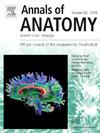免疫组化评价TRPC3和TRPC6在人子宫内膜异位症中的表达模式。
IF 2
3区 医学
Q2 ANATOMY & MORPHOLOGY
引用次数: 0
摘要
背景:尽管迄今为止,子宫内膜异位症的发病机制仍未完全解释,但已知的是,子宫内膜异位症的迁移、增殖和血运重建过程以及钙作为信使物质发挥了重要作用。随后,本研究检测了异位(宫腔外)子宫内膜组织中钙瞬时受体电位通道3和6 (TRPC3和TRPC6)的免疫组化表达。方法:腹腔镜下收集腹部多个不同部位的子宫内膜异位症组织并经组织形态学证实(n=20),用抗trpc3和抗trpc6抗体进行免疫组化染色(Alomone Labs, Jerusalem)。因此,异位子宫内膜作为健康对照队列(n=6)。采用改进的免疫反应评分(IRS)评估染色模式,并进行探索性统计分析,旨在确定染色强度与相关临床参数(如rASRM分期和位置)的关系。结果:我们在所有异位子宫内膜腺体形成中检测到强烈的细胞质TRPC3和TRPC6表达,尽管局部染色强度不同。在我们的队列中,我们没有验证子宫内膜异位症患者与健康对照组之间或不同临床症状(rASRM分期)之间TRPC3和TRPC6表达的统计学差异。结论:据我们所知,我们的研究首次证实了TRPC3和TRPC6在子宫内膜异位症中的成功免疫组化评估,为未来的研究奠定了基础,旨在评估TRPC3和TRPC6的临床表达,并阐明其在子宫内膜异位症病理生理背景下的功能。本文章由计算机程序翻译,如有差异,请以英文原文为准。
Evaluation of immunohistochemical TRPC3 and TRPC6 expression patterns in human endometriosis
Background
Although to date the pathogenesis of endometriosis remains largely unexplained, it is known that processes of migration, proliferation and revascularization and thus calcium as a messenger substance play an important role. Consecutively, the present study examines the immunohistochemical expression of the calcium transient receptor potential channels 3 and 6 (TRPC3 and TRPC6) in ectopically located (outside the uterine cavity) endometrial tissue.
Methods
Laparoscopically collected and histomorphologically verified endometriosis tissues from several different intraabdominal locations were examined (n = 20) and immunohistochemical stainings were performed with anti-TRPC3 and anti-TRPC6 antibodies (Alomone Labs, Jerusalem). Hereby, eutopic endometrium served as a healthy control cohort (n = 6). Staining patterns were evaluated using a modified immunoreactive score (IRS) and exploratory statistical analysis was performed, aiming to determine relations of staining intensities with associated clinical parameters such as rASRM stage and location.
Results
We determined a strong cytoplasmatic TRPC3 and TRPC6 expression in all ectopic endometrial glandular formations, albeit with focally varying staining intensities. Within our cohort, we did not verify a statistically significant difference of TRPC3 and TRPC6 expression between endometriosis patients and a healthy control group or between different clinical affections (rASRM stages).
Conclusions
Our study confirms - to our knowledge for the first time - the successful immunohistochemical assessment of TRPC3 and TRPC6 in endometriosis, setting the basis for future studies aiming at evaluating not only clinical aspects of TRPC3 and TRPC6 expression but also shedding light on its function in the pathophysiological context of endometriosis.
求助全文
通过发布文献求助,成功后即可免费获取论文全文。
去求助
来源期刊

Annals of Anatomy-Anatomischer Anzeiger
医学-解剖学与形态学
CiteScore
4.40
自引率
22.70%
发文量
137
审稿时长
33 days
期刊介绍:
Annals of Anatomy publish peer reviewed original articles as well as brief review articles. The journal is open to original papers covering a link between anatomy and areas such as
•molecular biology,
•cell biology
•reproductive biology
•immunobiology
•developmental biology, neurobiology
•embryology as well as
•neuroanatomy
•neuroimmunology
•clinical anatomy
•comparative anatomy
•modern imaging techniques
•evolution, and especially also
•aging
 求助内容:
求助内容: 应助结果提醒方式:
应助结果提醒方式:


